Order Dennstaedtiales | Division Pteridophyta Scientific name Pteridium Rank Genus | |
Similar Pteridium aquilinum, Dennstaedtiaceae, Pteridaceae, Pteris, Dryopteris | ||
Hw plant challenge 2 uses of bracken fern
Bracken (Pteridium) is a genus of large, coarse ferns in the family Dennstaedtiaceae. Ferns (Pteridophyta) are vascular plants that have alternating generations, large plants that produce spores and small plants that produce sex cells (eggs and sperm). Brackens are noted for their large, highly divided leaves. They are found on all continents except Antarctica and in all environments except deserts, though their typical habitat is moorland. The genus probably has the widest distribution of any fern in the world.
Contents
- Hw plant challenge 2 uses of bracken fern
- 2 bracken fern and life cycle wmv
- Description and biology
- Distribution
- Fungi associations
- Other plant associations
- Animal species that use bracken
- Uses
- Poisoning
- Archaeology
- Control
- References
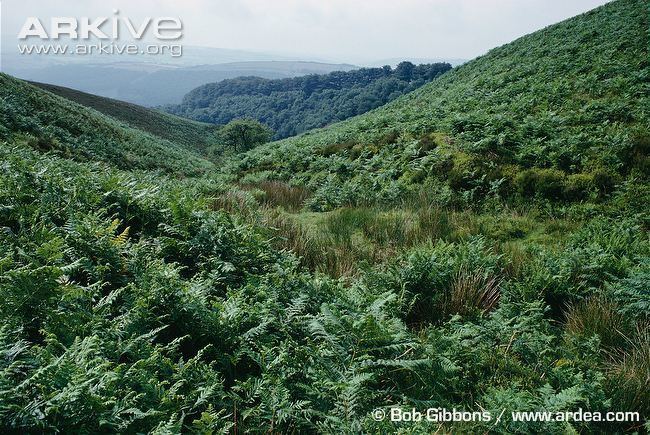
In the past, the genus was commonly treated as having only one species, Pteridium aquilinum, but the recent trend is to subdivide it into about ten species.
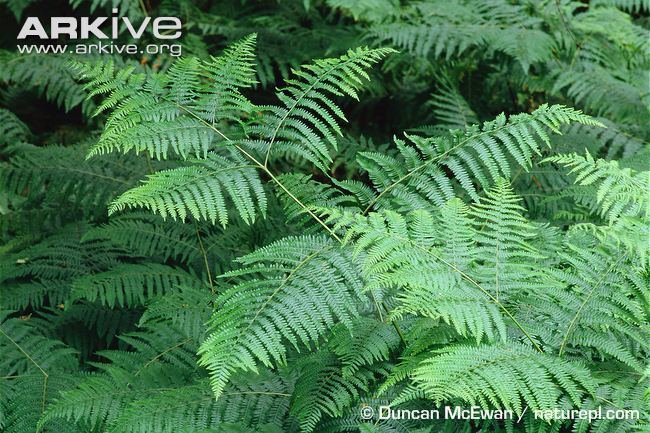
Like other ferns, brackens do not have seeds or fruits, but the immature fronds, known as fiddleheads, are sometimes eaten, although some are thought to be carcinogenic. (see Poisoning)
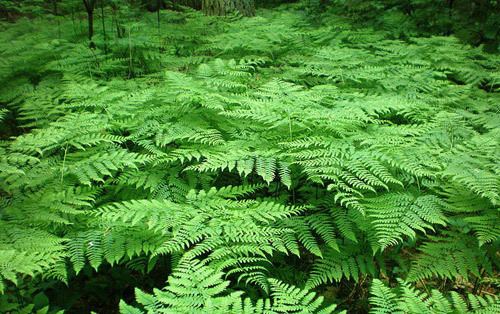
The word bracken is of Old Norse origin, related to Swedish bräken and Danish bregne, both meaning fern.
2 bracken fern and life cycle wmv
Description and biology
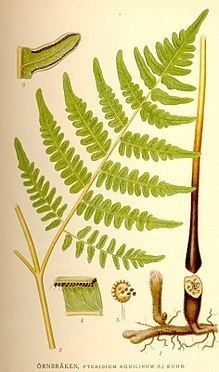
Evolutionarily, bracken may be considered one of the most successful ferns. Bracken, like heather, is typically found in moorland environments, and is commonly referred to by local populations in the north of England as 'Moorland Scrub'. It is also one of the oldest ferns, with fossil records over 55 million years old having been found. The plant sends up large, triangular fronds from a wide-creeping underground rootstock, and may form dense thickets. This rootstock may travel a metre or more underground between fronds. The fronds may grow up to 2.5 m (8.2 ft) long or longer with support, but typically are in the range of 0.6–2 m (2.0–6.6 ft) high. In cold environments, bracken is deciduous and, as it requires well-drained soil, is generally found growing on the sides of hills.
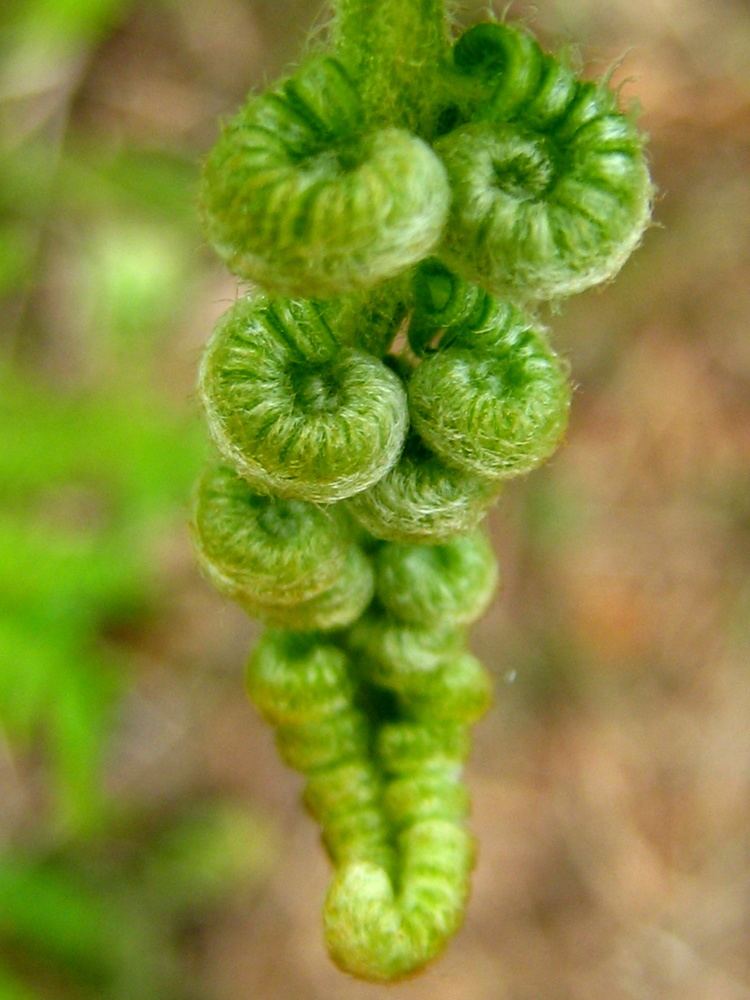
The spores are contained in structures found on the underside of the leaf called sori. The linear pattern of these is different from other ferns which are circular and towards the centre.
Distribution
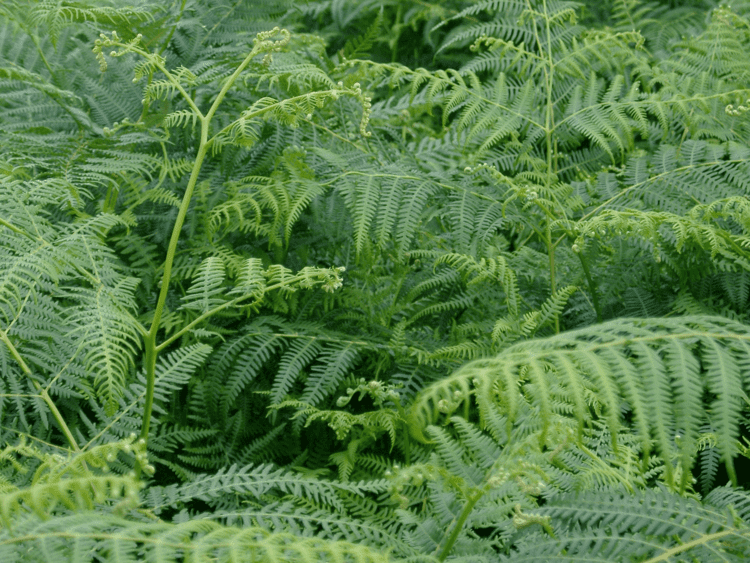
Pteridium aquilinum (bracken or common bracken) is the most common species with a cosmopolitan distribution, occurring in temperate and subtropical regions throughout much of the world. It is a prolific and abundant plant in the moorlands of Great Britain, where it is limited to altitudes of below 600 metres. It does not like poorly drained marshes or fen. It has been observed growing in soils from pH 2.8 to 8.6. Exposure to cold or high pH inhibits its growth. It causes such a problem of invading pastureland that at one time the British government had an eradication programme. Special filters have even been used on some British water supplies to filter out the bracken spores. NBN distribution map for the United Kingdom
Bracken is a characteristic moorland plant in the UK which over the last decades has increasingly out-competed characteristic ground-cover plants such as moor grasses, cowberry, bilberry and heathers and now covers a considerable part of upland moorland. Once valued and gathered for use as animal bedding, tanning, soap and glass making and as a fertiliser, bracken is now seen as a pernicious, invasive and opportunistic plant, taking over from the plants traditionally associated with open moorland and reducing easy access by humans. It is toxic to cattle, dogs, sheep, pigs and horses and is linked to cancers in humans. It can harbour high levels of sheep ticks, which can pass on Lyme Disease. Grazing provided some control by stock trampling but this has almost ceased since foot and mouth over ten years ago. Global climatic changes have also suited bracken well and contributed to its rapid increase in land coverage.
Bracken is a well-adapted pioneer plant which can colonise land quickly, with the potential to extend its area by as much as 1–3% per year. This ability to expand rapidly is at the expense of other plants and wildlife, can cause major problems for land users and managers. It colonises ground with an open vegetation structure but is slow to colonise healthy, well managed heather stands.
The biodiversity that depends on these uplands is very special and very rich. Many of the species only occur on upland moorland, tied to features unique to the habitat. The loss and degradation of such areas due to the dominance of bracken has caused many species to become rare and isolated.
Fungi associations
Woodland fungi can be found growing under the bracken canopy, for example Mycena epipterygia. Both Camarographium stephensii and Typhula quisquiliaris grow primarily from dead bracken stems.
Other plant associations
Allelopathy: Bracken fern is known to produce and release allelopathic chemicals, which is an important factor in its ability to dominate other vegetation, particularly in regrowth after fire. Its chemical diffusions, shady canopy and its thick litter inhibit other plant species from establishing themselves – with the occasional exception of plants which support rare butterflies. Herb and tree seedling growth may be inhibited even after bracken fern is removed, apparently because active plant toxins remain in the soil.
Brackens substitute the characteristics of a woodland canopy, and are important for giving shade to European plants such as common bluebell and wood anemone, where the woodland does not exist. These plants are intolerant to stock trampling. Dead bracken provides a warm microclimate for development of the immature stages. Climbing corydalis, wild gladiolus and chickweed wintergreen also seem to benefit from the conditions found under bracken stands.
The high humidity helps mosses survive underneath including Campylopus flexuosus, Hypnum cupressiforme, Polytrichum commune, Pseudoscelopodium purum and Rhytidiadelphus squarrosus.
Animal species that use bracken
Brackens of the Northern Hemisphere are used as food plants by the larvae of some Lepidoptera species including dark green fritillary, dot moth, high brown fritillary, gold swift, map-winged swift, pearl-bordered fritillary, orange swift, small angle shades, small pearl-bordered fritillary. They also form an important ecological partnership with plants such as violet and cow-wheat (Melampyrum pratense) for various Boloria fritillary species.
It is also a favoured haunt of the sheep tick Ixodes ricinus which can carry lyme disease.
Between 27 and 40 invertebrates (including nine moths) in the UK feed on bracken. These include the sawfly, a planthopper (Dytroptis pteridis), the map-winged swift moth caterpillar, brown silver-line moth caterpillar (Petrophora chlorosata) and Paltodora cytisella. The numbers feeding on the bracken increase as the season progresses due to the decreasing levels of toxin, and the production of nectaries in the spring, food for ants which in turn may kill any herbivorous insects in the vicinity.
Where bracken is dominant it excludes most specialist heathland/moorland bird species of conservation concern, although there are a few species that may benefit from a certain proportion of bracken. Deeper bracken stands provide a good food site for many resident or breeding birds, such as threatened ground-nesting species skylark, yellowhammer, curlew and lapwing. Some British birds such as the whinchat and the nightjar use bracken as their preferred habitats. The nightjar may lay its eggs on the bare ground under the bracken. The skylark often nests in bracken and uses it for cover. Small stands of bracken provide nesting, feeding and roosting habitat for a variety of smaller birds, including the willow warbler (which will also use bracken to construct its nest), the tree pipit, the yellowhammer, the ring ouzel, the woodcock and the twite.
These stands also give cover, especially during the nesting season, from predators such as birds of prey and crows; and from free-ranging dogs and users straying off the paths which, usually unintentionally, disrupts nesting and can identify the nest site to predators. On heavily used spaces, this may be an important protection.
The European adder can be found basking on bracken, the colour of their skin concealing them.
Uses
Bracken fiddleheads (the immature, tightly curled emerging fronds) have been considered edible by many cultures throughout history, and are still commonly used today as a foodstuff. Bracken fiddleheads are either consumed fresh (and cooked) or preserved by salting, pickling, or sun drying. In Korea, where they are called gosari (고사리), they are a typical ingredient in the mixed rice dish called bibimbap.
The British Royal Horticultural Society recommends against consumption of bracken either by humans or livestock, since it contains carcinogens linked with oesophageal and stomach cancer. However, the poison found in bracken, ptaquiloside, is both water-soluble and is destroyed in heat and alkaline conditions. Despite this, moderation of consumption is still recommended to mitigate chance of throat and stomach cancers.
Both fronds and rhizomes have been used to brew beer, and the rhizome starch has been used as a substitute for arrowroot. Bread can be made out of dried and powdered rhizomes alone or with other flour. Indigenous peoples of the Americas cooked the rhizomes, then peeled and ate them or pounded the starchy fiber into flour. In Japan, where it is known as warabi (蕨), starch from the rhizomes is used to make confections, most significantly warabimochi.
Bracken is called wiwnunmí útpas ‘huckleberry’s blanket’ by the Umatilla Indians of the Columbia River in the United States Northwest. The fronds were used to cover a basket full of huckleberries in order to keep them fresh.
The Māori of New Zealand used the rhizomes of P. esculentum (aruhe) as a staple food, especially for exploring or hunting groups away from permanent settlements; much of the widespread distribution of this species in present-day New Zealand is in fact a consequence of prehistoric deforestation and subsequent tending of aruhe stands on rich soils (which produced the best rhizomes). The rhizomes were air-dried so that they could be stored and became lighter; for consumption, they were briefly heated and then softened with a patu aruhe (rhizome pounder); the starch could then be sucked from the fibers by each diner, or collected if it were to be prepared for a larger feast. Patu aruhe were significant items and several distinct styles were developed.
In East Asia, Pteridium aquilinum (fernbrake or bracken fiddleheads) is eaten as a vegetable, called warabi (蕨 / わらび) in Japan, gosari (고사리) in Korea, and juécài (蕨菜) in China and Taiwan. In Korea, a typical banchan (small side dish) is gosari-namul (고사리나물) that consists of prepared fernbrake that has been sauteed. It is a component of the popular dish bibimbap.
Bracken has been shown to be carcinogenic in some animals and some have suggested it could have some part in causing the high incidence of stomach cancer in Japan. It is currently under investigation as a possible source of new insecticides.
Uncooked bracken contains the enzyme thiaminase, which breaks down thiamine. Eating excessive quantities of bracken can cause beriberi, especially in creatures with simple stomachs. Ruminants are less vulnerable because they synthesize thiamine.
It was traditionally used (and still is in certain areas like mid-Wales) for animal bedding, which later broke down to a rich mulch which could be used as fertilizer.
When used by gardeners as a winter mulch it has been shown to reduce the loss of potassium and nitrogen and to lower soil pH.
Other uses were as packing material for products such as earthenware, as a fuel, as a form of thatch. The ash was used for degreasing woolen cloth.
The ash of bracken fern was used in making forest glass in Central Europe from about 1000 to 1700.
Bracken is currently harvested in the Lake District, Cumbria, United Kingdom to make commercial composts.
A quick and easy remedy for nettle stings is to rub bracken on the affected area. The juice it releases alleviates the sting, and bracken often grows near stinging nettle.
Poisoning
The plant is carcinogenic to animals such as mice, rats, horses and cattle when ingested, although they will usually avoid it unless nothing else is available. Young stems are quite commonly used as a vegetable in China, Japan and Korea. However, some researchers suspect a link between consumption and higher stomach cancer rates. The spores have also been implicated as a carcinogen. Danish scientist Lars Holm Rasmussen released a study in 2004 showing that the carcinogenic compound in bracken, ptaquiloside or PTA, can leach from the plant into the water supply, which may explain an increase in the incidence of gastric and esophageal cancers in bracken-rich areas.
In cattle, bracken poisoning can occur in both an acute and chronic form, acute poisoning being the most common. In pigs and horses bracken poisoning induces vitamin B deficiency. Poisoning usually occurs when there is a shortage of available grasses such as in drought or snowfalls.
Along with the DNA damage caused by ptaquiloside it is shown that chemicals in the fern can damage blood cells and can destroy Vitamin B1. This in turn causes beriberi, a disease normally linked to nutritional deficiency.
Hydrogen cyanide is released by the young fronds of bracken when eaten by mammals or insects. Two major insect moulting hormones, alpha ecdysone and 20-hydroxyecdysone, are found in bracken. These cause uncontrollable, repeated moulting in insects ingesting the fronds, leading to rapid death.
Archaeology
Many sites have many archaeological remains dating from the Neolithic and Bronze Ages through to the Industrial Revolution. The root systems of established bracken stands degrade archaeological sites by disrupting the strata and other physical evidence. These rhizomes may travel a metre or more underground between fronds and form 90% of the plant, with only the remainder being visible.
Control
Some small level of scattered cover can provide beneficial habitats for some wildlife, at least in the UK (as given above). However, on balance, removing bracken encourages primary habitats to re-establish, which are of greater importance for wildlife. Control is a complex question with complex answers, which need to form part of a wider approach. Management can be difficult and expensive; plans may need to be about cost-effective, practical limitation and control rather than give an expectation for eradication.
All methods need follow-up over time, starting with the advancing areas first. Given the decades elapsed to arrive at the current levels of coverage on many sites, slowing or reversing the process will be also of necessity long-term, with consistency and persistence from all parties being key.
Various techniques are recommended by Natural England and the RSPB to control bracken either individually or in combination RSPB Bracken management in the uplands.
Natural England recommends that only Asulam can be sprayed aerially, Glyphosate requires spot treatment, e.g. using a weedwiper or knapsack spray. The toxicity of Asulam is low and has been generally highly cost-effective but its use is now restricted by the EU after 2012, at least until specific registered uses can be defined.
Selective sprays like Starane, Access, Metsulfuron 600WG, etc. work well but only if sprayed in late autumn so the rhizomes store food for winter and hence absorb the poison.
On archaeological sites, chemical control is usually required as mechanical methods may cause damage.
Any bracken control programme must be completed, or bracken will re-establish.
A Bracken Control Group was established in 2012 to provide best-practice guidance for all bracken control techniques. The Group has also been responsible for submitting an application for an Emergency Authorisation to secure the continued availability of Asulam for bracken control, following the decision not to register the product under new regulations in the EU. Registration has been re-applied for but this will not be available until 2017 at the earliest. Until re-registration is approved the Group will aim to keep Asulam available under the emergency provisions. Bracken Control Group website
